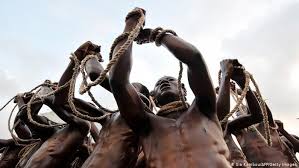SLAVE TRADE IN INDIAN OCEAN
Slave is the person who is illegally owned and controlled by another person and is forced to work for them.
Slavery is an act of owning and using slaves.
Slave trade is the activity of buying and selling human beings like other commodities.
Slave trade in East Africa began after the arrival of Portuguese in 15th Century up to 1873 during the Sayyid Barghash treaty or free treaty.
Africa experienced two types of slave trade.
<> The Indian Ocean slave trade which was conducted by Asians.
<> The Trans-Atlantic Ocean slave trade conducted by European merchants.
THE INDIAN OCEAN SLAVE TRADE
Main peoples involved: Arab traders, European merchants, African chiefs e.g. Mirambo and NyunguyaMawe, The Nyamwezi, The Kamba, The Yao, Buganda, Banyoro, Khartoumers.

REASONS FOR THE EXPANSION OF THE INDIAN OCEAN SLAVE TRADE
1. Introduction of clove plantations in Zanzibar and Pemba.
The Oman Arabs who were ruling the East African coast at the time introduced Cloves plantations, these plantations required large numbers of labors to work in those farms, and hence slaves were taken.
2. High demand for slave labor for the French sugar cane plantations in Mauritius and Reunion Island.
Initially, the French mostly depended on the area around present-day Mozambique for slaves, but by the 1770s the demand exceeded supply. Hence, the French came further north, to East Africa, in search of slaves.
3. Slaves were needed as porters.
They ferried goods such as ivory and gold from interior of Africa to the Coast.
4. Portuguese slave traders supplied slaves to the Portuguese coffee and sugar plantations in Brazil.
In the first half of the 18th century, the Portuguese expanded their plantations. As a result, their sources of slaves in West Africa and Mozambique became inadequate, so they came to East Africa.
5. Slaves were in great demand as domestic workers and soldiers in the Muslims nation Arabia.
The Quran forbids Muslims from enslaving other Muslims. Thus, the slaves had to come from non-Muslim regions such as the interior of East Africa. There were major slave markets in Zanzibar, Bagamoyo, Pemba, Kilwa, Mikindani and Mombasa.
CHARACTERISTICS OF SLAVE TRADE
There were characteristics which prevailed during slave trade.
1. There were several human torture and transits.
2. Humiliation and dehumanization of the slaves.
3. Slave were chained and forced to carry heavy loads like salt, ivory and copper.
4. They were brutally whipped by their organizers.
5. They were blended like animals. Those who were unfit were killed or left to die on the way.
HOW SLAVES WERE OBTAINED (TECHNIQUES USED TO OBTAIN SLAVES)
Slaves were obtained through various ways:
1. Through raiding villagers and capturing people.
2. Through selling prisoners of war obtained from local civil wars.
3. Through selling criminals.
4. Through selling of domestic slaves.
5. Through ways of laying and ambush.
6. Through use of trickery and false pretense.
7. Through inter-tribal wars many Africans become destitute.
IMPACTS OF SLAVE TRADE IN INDIAN OCEAN SEA BOARD

A: SOCIAL EFFECTS
1. Depopulation; many people were taken to work as slaves and others died on the way.
2. Insecurity and fear among the people.
3. Development of inter-states war.
4. Human torture and suffering
5. Hunger due to lack of good in areas where slave trade operated.
6. Growth of Arab towns such as Tabora and Ujiji.
7. Eruption of diseases among overcrowded slaves. E.g., The Spaniards introduced Syphilis.
8. Displacement of people and many became homeless.
9. Introduction of Swahili language, this was introduced in land and is now being widely spoken in Tanzania, Kenya, Uganda and eastern Congo.
10. Introduction of Islamic religion, Islam as a religion was introduced by the Arabs and it spread, especially in Yao land and in Buganda land.
B: ECONOMIC EFFECTS
1. Killing of economic activities, agriculture, pastoralism and industries were killed due to lack of manpower.
2. Technology stagnation, no innovation was made as all able-bodied people were taken as slaves only children and old ones were left behind.
3. Underdevelopment of East Africa, slave trade increased dependence on European capitalist countries. Generally, slave trade had negative effects in East Africa and it created many problems
4. Introduction of new foods.g. maize, pawpaws, rice, and groundnuts.
5. The increase of farming plantations, in some areas especially the clove plantations were slaves worked.
PSYCHOLOGICAL EFFECTS OF SLAVERY ON ITS VICTIMS
1. Damage of slave’s self-worth.
2. Inferiority complex before their masters.
3. Sufferings due to difficult work.
4. Separation of families and homes.
5. Stress due to unsure about their future, survival and food.
6. Fear and Insecurity.


























































